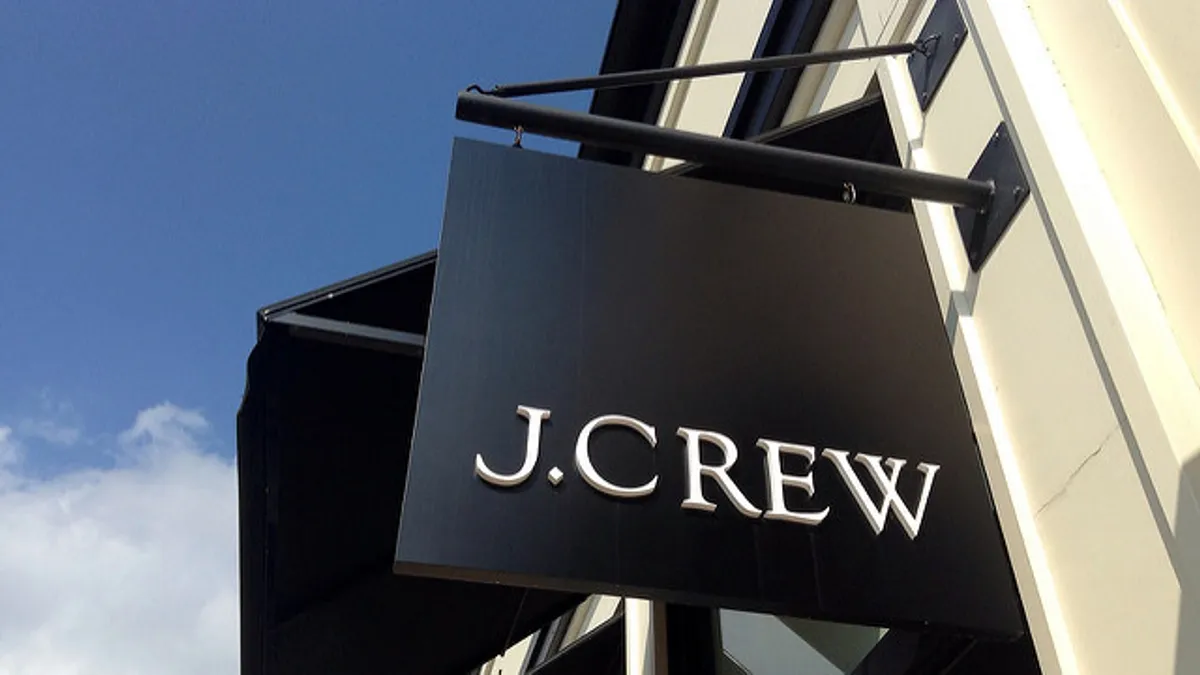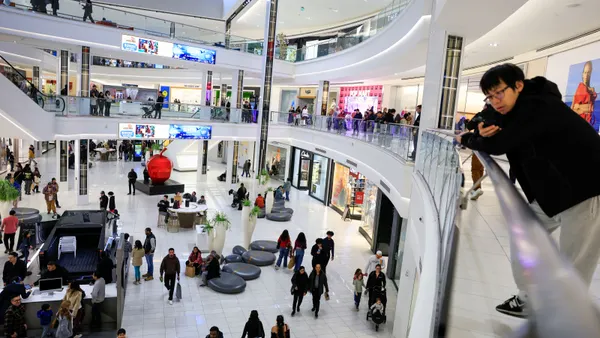A pandemic brought down J. Crew. At least, that's the narrative most casual observers will remember about J. Crew's bankruptcy. A story will be told that the end of a retail era was brought on by a global crisis that no one could have predicted.
Yet, J. Crew has been on a precarious ledge for years. In bankruptcy court documents, the retailer's COO, Michael Nicholson, revealed that the company has been working since 2016 to shed its now nearly $2 billion in funded debt. That's a significant sum for an apparel retailer that has struggled to remain relevant, especially when it comes to its namesake brand.
With hindsight, it's not hard to see that a new age of retail started when J. Crew hired Jenna Lyons. In 1990, the company hired a new assistant designer straight out of Parsons and thereby put into motion a series of events that would bring about the pinnacle of mall specialty retail, followed swiftly by a crash and burn.
Yet, pinning the rise and fall of a retailer on one person is neither accurate nor fair. Lyons was given room to grow and flourish once she was under the direction of Millard "Mickey" Drexler. Drexler had previously been a director at Apple, and then the CEO of Gap Inc. before he landed at J. Crew. The two made an unlikely pair, but together they designed and executed a vision to build a brand that was synonymous with style.
It almost worked.
At a quick glance, the below timeline is simply a set of events at one company. Upon closer inspection, a dramatic narrative is revealed about the changing state of retail. There is, quite simply, a "before" and an "after." There was the way that retail always worked, where stores and designers dictated what consumers wanted. Then, there's the after where everything changed.
People started buying clothes online versus going to malls. The Great Recession hit and customers were looking for inexpensive, trendy clothes instead of investment pieces. Social media exploded and launched a wide variety of style influencers to mass audiences. Traditional retailers who were slow to catch on were left scrambling, trying to understand the market while insisting that retail wasn't changing.
The story of J. Crew encapsulates both the potential and the heartache of the trajectory of the industry. Of the below timeline, Liz Dunn, founder and CEO of retail analytics and consulting firm Pro4ma, previously stated to Retail Dive that it tells, "a very clear story of not only the evolution of J. Crew, but also the evolution of retail from this standpoint in the 90s and the 2000s where we were all sort of believing in the idea of the 'merchant prince' or 'princess,' as the case may be."
Reading through nearly 30 years of decision-making at the company is startling. At points, the retailer was an industry leader. At other junctures, executive leadership appeared to deeply misjudge and misread economic clues. But the cultural relevance of the retailer makes it an important touchstone in recent fashion history. Whether the company is able to restructure and then compete in a post-pandemic world remains to be seen.
-
1947
Popular Merchandise, Inc. is founded by Mitchell Cinader and Saul Charles.
-
1983
Popular Merchandise Inc. becomes known as J. Crew, Inc. and mails its first catalog.
-
1988
The company launches J. Crew Factory.
-
1989
J. Crew opens its flagship store at New York's South Street Seaport.
-
1990
Jenna Lyons starts at J. Crew as an assistant designer in menswear after graduating from Parsons School of Design.
-
1997
TPG Capital buys an 88% stake in the company for approximately $500 million.
-
2003
Millard "Mickey" Drexler brought in as CEO. He buys the name to Madewell.
-
2004
J. Crew launches The Bridal Collection.
-
2005
"Mickey Drexler's Second Coming" appears in Fortune magazine.
-
2006
J. Crew goes public.
Madewell is launched.
-
2008
Drexler appoints Lyons as the executive director of J. Crew.
First Lady Michelle Obama wears J. Crew on The Tonight Show with Jay Leno.
Lyons introduces the J. Crew Collection featuring an $800 skirt and $1,900 sweater during the recession.
-
2010
Drexler appoints Lyons as the president of J. Crew.
J. Crew announces that they will be taken private in a $3 billion deal. The New York Times reports that Drexler waited seven weeks to inform the board he was discussing the buyout. He reportedly received a net result of $200 million in cash and an 8.8% stake in the new company.
J. Crew starts showing its collections at New York Fashion Week.
-
2011
J. Crew's leveraged buyout by TPG Capital and Leonard Green & Partners is finalized.
-
2012
The company launches e-commerce operations in more than 100 countries.
-
2013
"Jenna Lyons, the Woman Who Dresses America" appears in The New York Times. Drexler states of Lyons, "She is, in my opinion, one of the most talented, trained, intuitive and commercial designers that I have ever met."
"How Jenna Lyons Transformed J. Crew into a Cult Brand" appears in Fast Company.
-
2014
J. Crew goes from a net income of $35.4 million to a reported loss of $607.8 million in one year.
Moody's Investors Service downgraded J. Crew due to a, "declining earnings trend stemming from weak execution in a challenging apparel retail environment."
-
2015
Writer and illustrator Tricia Louvar writes "An Open Letter to Jenna Lyons" for website The Hairpin that expresses dismay over J. Crew's prices and a misunderstanding of its core audience. The post goes viral.
-
2016
J. Crew's long-term debt is approximately $2 billion.
The company shutters The Bridal Collection.
Drexler gives out his email address so customers can contact him directly.
-
2017
April 3 - Jenna Lyons leaves J. Crew as part of a "mutual decision." She is replaced by Somsack Sikhounmuong, who was previously head of women's design.
April 25 - The company announces it will terminate 250 jobs, including 150 full-time jobs and 100 open positions, as part of a cost-cutting measure.
May 24 - Drexler gives an interview with The Wall Street Journal where he confesses that he underestimated the influence of technology on retail. "We became a little too elitist in our attitude," he says. Sales at stores had fallen for the past 10 quarters. "We gave a perception of being a higher-priced company than we were — in our catalog, online, and in our general presentation. Very big mistake," he says.
June 5 - Drexler steps down. He is replaced by former West Elm President James Brett.
June 13 - After reporting plunging revenues the company announces plans to restructure its debt through a debt swap.
Sept. 6 - Chief Design Officer Somsack Sikounmuong steps down. J. Crew decides not to replace him and announces that the role will be absorbed by staff.
Sept. 7 - Fast Company releases the article "J. Crew is falling apart and right before New York Fashion Week." J. Crew is absent from the NYFW schedule.
Nov. 9 - Former CEO Drexler reveals that he approached Amazon about a possible sale but came to the conclusion that selling J. Crew products through the e-commerce giant would undermine their brand.
Nov. 22 - Announces 50 store closures.
Dec. 27 - Quietly launches new "untucked" shirt option with a more relaxed fit.
-
2018
Jan. 16 - Announces the closure of some stores and outlets.
Feb. 15 - Announces a partnership with WeWork.
Feb. 16 - The company hires former Starbucks executive Adam Brotman as president and chief experience officer.
Feb. 26 - Launches a shop-in-shop concept where Madewell products will be available for purchase in some J. Crew stores.
April 25 - Wins a lawsuit over a debt swap transaction.
May 15 - Moody's Investors Service raises the company's outlook to "positive" due to earnings improvements, cost cuts and Madewell's growth.
June 18 - Announces that the former creative director at West Elm, Johanna Uurasjarvi, will be J. Crew's chief design officer.
July 10 - Announces a partnership with Universal Standard for an inclusive fall and summer collection.
Aug. 1 - Opens a men's store in Brooklyn, New York, that includes local brands in the fashion, grooming and home goods categories.
Aug. 6 - Announces a loyalty program.
Sept. 5 - Announces it will be selling its Mercantile line through Amazon.
Sept. 12 - Opens a third-party marketplace. Madewell launches a menswear line.
Sept. 25 - Announces the launch of a new line aimed at younger women.
Nov. 13 - The Nevereven branch launches on Facebook.
Nov. 17 - Announces that CEO James Brett will step down after just over a year on the job.
Nov. 23 - The company's website crashes on Black Friday. Analysts estimate that the company lost $775,000 in sales within the first five hours of the outage. The site continues to have glitches through Cyber Monday.
Nov. 29 - The company states in an internal memo that it will discontinue its Mercantile and Nevereven brands, the latter of which was launched only 16 days earlier.
-
2019
Jan. 18 - Mickey Drexler announces his retirement as chairman of the company. Chad Leat, who has served as a director of the company since 2017, is elected to succeed Drexler as chairman. Drexler will continue to serve as a strategic advisor to the board and the office of the CEO.
Jan. 31 - The Business of Fashion reveals that Stefan Larsson is in talks to be the next CEO. Larsson was the former CEO of Ralph Lauren.
March 20 - WWD reports that Stefan Larsson is no longer being considered for the CEO position.
March 29 - The company is once again in restructuring talks as it grapples with its debt. J. Crew is down to $25 million in cash.
April 3 - Madewell appoints its first CEO, Libby Wadle.
April 12 - J. Crew mulls the possibility of an IPO for its Madewell brand. President and COO Michael Nicholson is named interim CEO of J. Crew Group. The announcement replaces the four-person Office of the CEO, which led the company since November 2018.
May 29 - The retailer announces its intentions to close around 20 J. Crew and factory stores.
July 29 - Women's Wear Daily reports that J. Crew eliminated dozens of positions at its New York corporate office.
Aug. 14 - J. Crew announces a partnership with Hatch for its first maternity collection.
Sept. 13 - Madewell files for an IPO and announces a split from its sister company, J. Crew.
Sept. 30 - Moody's Investor Service says the company may be overestimating Madewell's value. Analysts also express doubt about Madewell's and J. Crew's growth potential.
Oct. 15 - Madewell announces a partnership with apparel resale company ThredUp.
-
2020
Jan. 28 - Jan Singer is announced as CEO of the J. Crew brand.
March 2 - The retailer announces it will pause on the proposed Madewell IPO.
May 4 - J. Crew files for Chapter 11 bankruptcy protection and decides Madewell will remain a part of the company. The company has $400 million in financing lined up and a pre-negotiated deal with a majority of lenders that would have nearly $1.7 billion in debt converted into equity.















